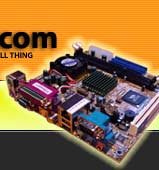EPIA Video Playback Tests
Many people purchase EPIAs as multimedia playback
devices. There are several different media formats widely
available for purchase and download. Different formats are
encoded at varying degrees of compression - some easier to
decode than others. The EPIA Ms are optimised for MPEG2 decoding,
so should use less CPU time to achieve the same results as
a classic EPIA.
In all our graphs we show green as watchable,
yellow as borderline, and red as unwatchable. We took average
CPU utilisation figures to draw the length of the bars.
We chose 7 representative samples and checked
the CPU utilisation whilst playing back a movie at full screen
in 1024x768 resolution, with default DivX playback quality
settings for DivX content. We watched for stutters, loss of
audio sync, bad picture quality and general nastiness.
We used Cyberlink PowerDVD
and the Core
Media Player for playback, and the Windows task manager
to measure CPU utilisation. Anything peaking at 100% is bad,
causing loss of picture or audio quality. The task manager
is that thing hiding in your taskbar that produces graphs
something like this:
VCD Playback
None of the boards had difficulties playing
a VCD at full screen. VCD is a very loosely compressed MPEG1
format, requiring little CPU.
320x240 DivX 3 AVI Playback
Results were almost identical to the VCD -
no problems, smooth playback, and all over a LAN from another
PC. This AVI size is common for small TV clips, requiring
much less pixel crunching than a full-resolution DivX movie.
DVD Playback
Our first casualty. The EPIA 5000 exhibited
glitches during DVD playback, which we lessened but didn't
entirely remove by reducing the resolution to 800x600. We
classed this as borderline - OK for previewing a movie, but
not much more. The EPIA 800 exhibited some occasional minor
glitches, but nothing particularly bothersome. We suspect
some tweaking would remove those altogether. The EPIA Ms all
had no problems, delivering a smooth, clear picture - as you
would expect from a chipset optimised for MPEG2 decoding.
Remember to turn the hardware acceleration in PowerDVD *on*
before playing DVDs for the first time on your EPIA.
SVCD Playback
SVCD playback proved slightly easier than
DVD playback for the classic EPIAs, although the EPIA 5000
had very occasional glitches. For some reason the ME6000 required
more CPU to complete the task, but still delivered a vibrant
full screen picture. SVCD is an MPEG2 based codec, and PowerDVD
was happy to use the hardware decoding of the EPIA Ms. SVCD
and VCD are well defined formats, with standardised bit rates
for video and audio.
DivX3 AVI Playback
Content in the DivX format abounds on the
internet and varies widely in quality and bit rates. There
are no fixed standards - one encoder might use the default
settings in their ripping program, another might perform all
manner of processing wizardry to squeeze the best picture
onto a 700MB CD. We chose 2 movies with different bit rates
and encoding methods and a third XviD movie for good measure.
These are the results for a DivX 3 encoded
movie, which had a 843 kBits/s video stream and 96 kBits/s
audio stream. The EPIA 5000 froze every second or so, rendering
it unwatchable. Both the ME6000 and EPIA 800 lacked the processing
muscle to playback perfectly, glitching occasionally. Other
DivX content with a slightly lower bandwidth would play on
these machines - we suspect a decent Linux based player would
tip the balance in their favour. The remaining EPIA Ms had
no such problems, producing smooth video straight from the
CD.
DivX4 with AC3 AVI Playback
Our next choice was a DivX4 encoded movie
with an 1810 kBit/s video stream and 384 kBits/s AC3
audio stream. To pass this test, the CPU not only had to decompress
the video, but decode the surround sound too. We didn't expect
the classic EPIAs or ME6000 to manage this, and they couldn't
- freezing every second or so. The M9000 had a few problems
with occasional glitches, though the M10000s both managed
without any loss of quality. We prevented ourselves from turning
our M9000 into an M10000 by overclocking
it - tempting though it was. This was probably the trickiest
DivX movie we could find.
XviD with AC3 AVI Playback
Finally, we chose an XviD encoded movie with
AC3 to see what the differences were. As before the slower
trio had problems - enough to make the movie unwatchable.
The M9000 had occasional glitches, and the M10000s both produced
excellent results.
Optimising
Video Playback
We used recent DivX
and XviD
codecs running on Windows XP with a standard stick of 256MB
PC133 or PC2100 RAM, and chose default playback quality settings
at 1024x768 resolution. We chose this as a typical setup -
but it is NOT the fastest possible. We would recommend looking
at Linux based media players and/or faster decoders such as
3vix.
In borderline cases, try reducing the video resolution or
playback quality settings - and make sure hardware acceleration
is enabled. With these optimisations, your EPIA will better
our test results.
Mini-ITX
Cases and Systems, Conclusion -->







